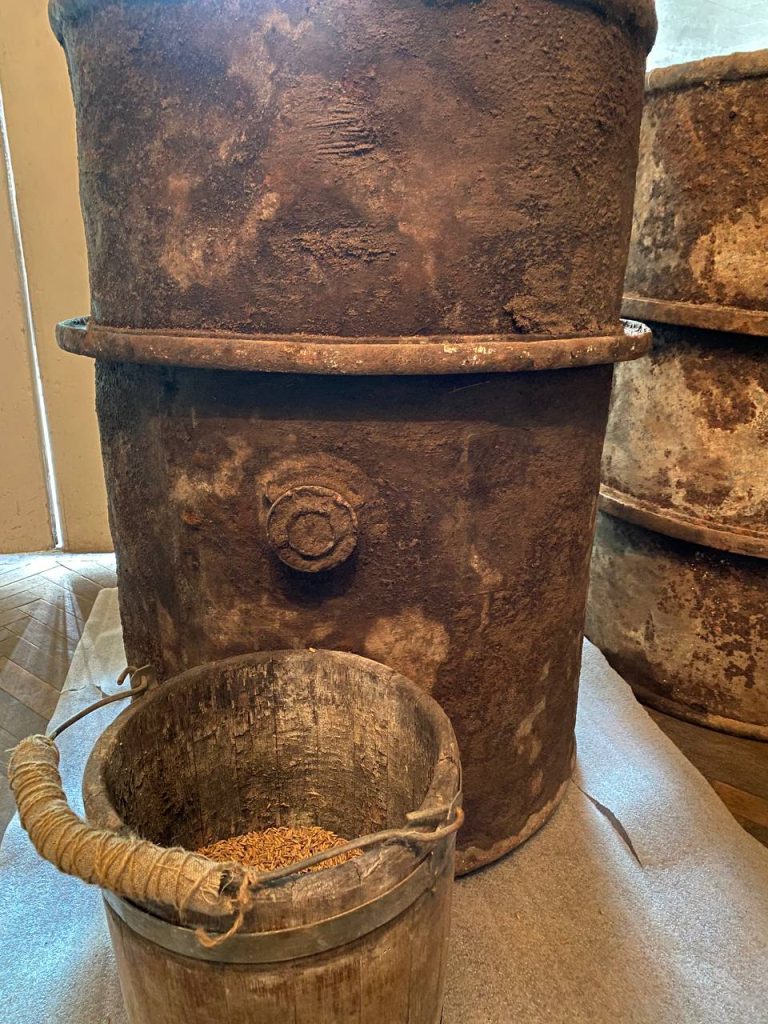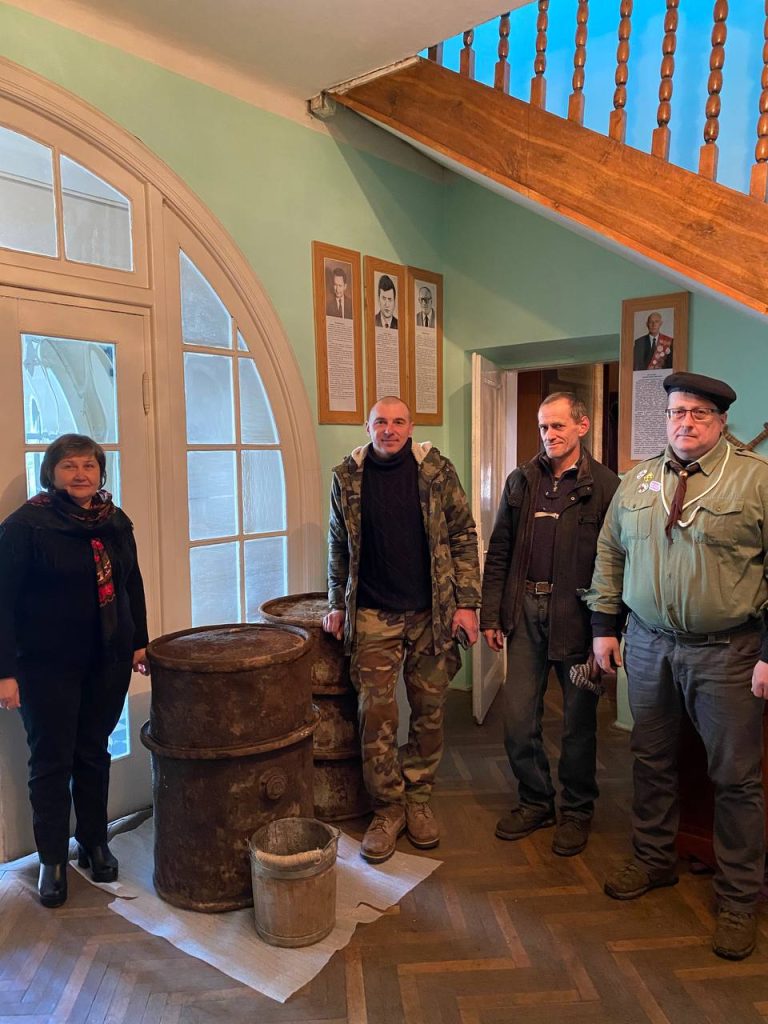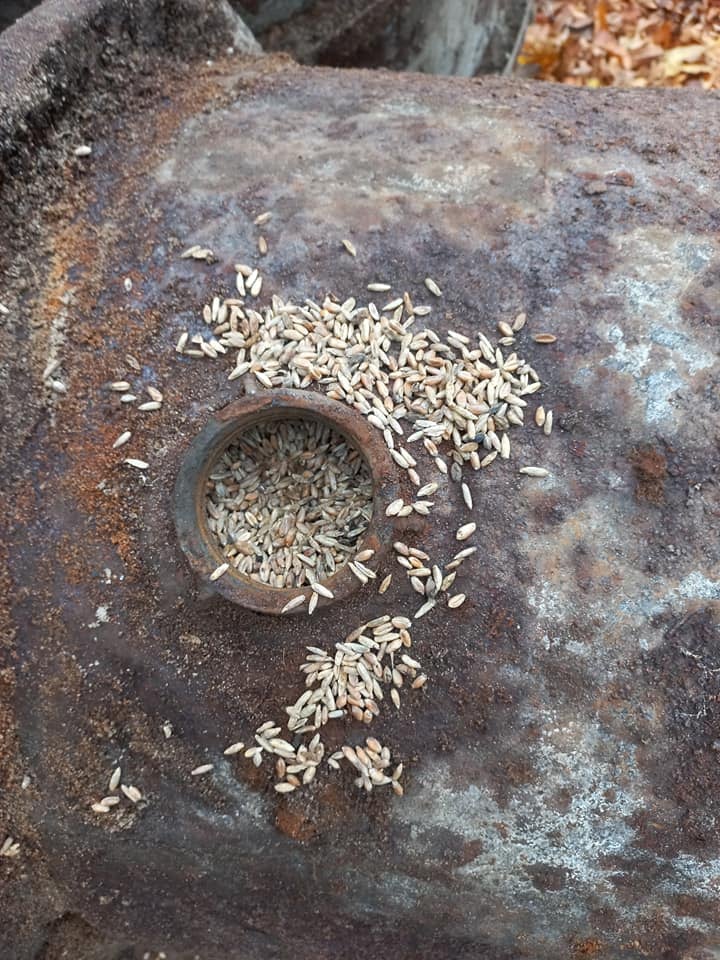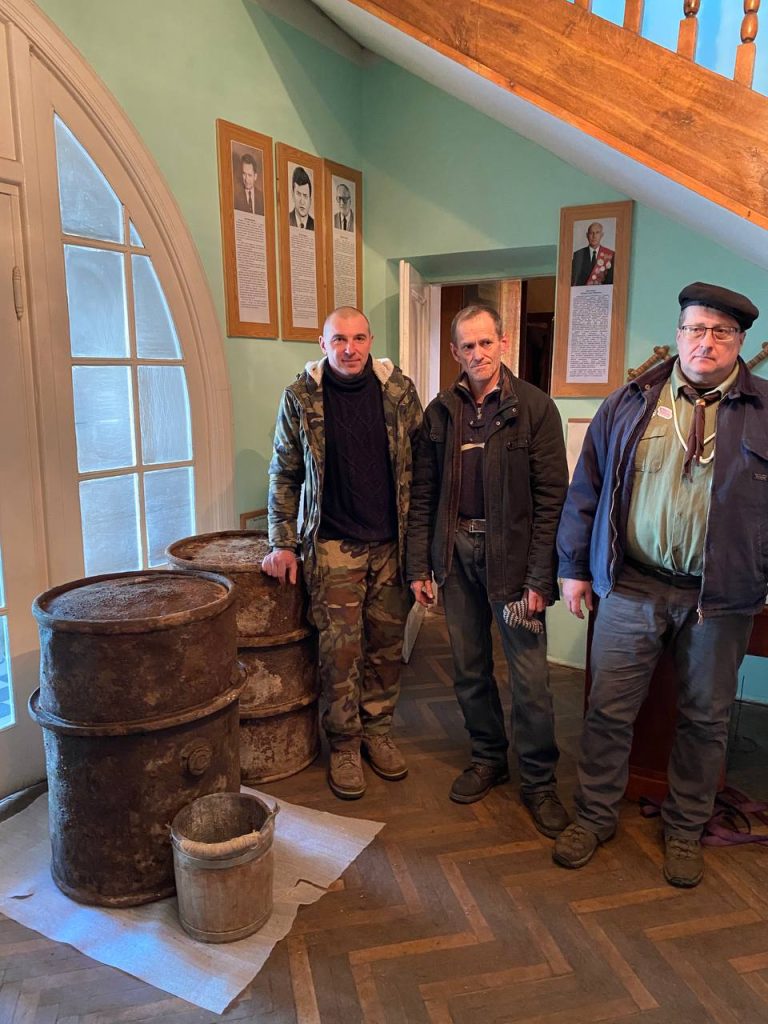
In the Lviv region, near the village of Chemeryntsi, in a place called “Golyi Kinet” (Naked End), two metal barrels filled to the brim with grain were discovered.
This was reported by Mykola Bandrivsky and the Culture Department of the Executive Committee of the Peremyshliany City Council. The event took place on 10 November 2021.

This accidental artefact, found by so-called “black diggers” in the forest four years ago, is valuable evidence of the tragic events of the past.

Residents of Peremyshliany: Mykola Oliinyk, Bartkiv Hennadiy, and Serko Volodymyr made a special gift to our museum—barrels of grain, which may be witnesses to the famine of 1946–1947…
These barrels were found in the forest near the village of Chemeryntsi, in the “Golyi Kinet” tract, near the manor road.

Historians suggest that the barrels may be linked to the mass famine that swept through Galicia in 1947, spreading from Bessarabia. Older generations, including the author’s mother and grandmother, recalled these events. Why the grain was not used by those who hid it remains a mystery.

Today, these barrels have been transferred to the historical and local history museum in the town of Peremyshliany.

Such findings seem to speak to our consciousness, reminding us of the difficult post-war years in western Ukraine under Soviet rule. These are not just museum exhibits, but emotional evidence of the past that should be remembered.

Here is one of the interesting comments under this post on another thread: “…Romana Pyastka
My grandmother told me how starving “Basarabs” died under fences with swollen feet. Anyone with swollen feet was doomed. My grandmother had some things from the Basarabs, as she called them, which she had exchanged for food. Among other things, there was a beautiful white suit, lying in the attic… The wool was so thin, the skirt was pleated. For a bucket or two of potatoes… My grandmother spoke with trembling in her voice about those people, because she herself had experienced hunger during the war in 1942. It was a bad harvest, a rainy year. But the Germans allowed children to be taken to Volhynia. My grandmother did this herself. My mother’s two sisters were taken there and forcibly given to people. Then they returned home. My mother stayed in Lviv. These are the things my ancestors told me.”
Lesya Siletska. I also have similar memories of my grandmother. My mother’s family lived in Strashivychi near Sambir until 1947. When the Basarabians came into the yard, they didn’t even ask if there was potato stew for the pigs under the house — they just ate it straight from the pot. The people in the village shared what they could. My father’s mother said that in Lviv, in order to survive, she exchanged gold rings and porcelain for bread from speculators.
Roman Moskal
In 1946-1947, the famine reached the south of Stanislaviv region (Sniatyn, Horodenka); as far as I know, it did not reach further north. Perhaps the barrels contained grain for the underground or hidden from the collective farm.
Mykola Bandrivsky
When digging their pits, these “diggers” sometimes unearth amazing and interesting things! And here I am not talking about material valuables, but about things that are immoral to put up for sale for profit (for example, like those two barrels of grain from the post-war Holodomor in Galicia).
I am referring to another group of finds that “black diggers” occasionally come across, namely: aluminium or zinc cans (from milk?), which are sometimes filled to the brim with archives of regional branches of the UPA, postcards from that time, photographs of UPA members, documents and awards of Soviet soldiers and officers, including MGB employees, etc.
Almost every second or third month, I record reports of such “surprise” containers being found in the forests of Lviv, Ternopil, and Ivano-Frankivsk regions. According to my calculations, between 2018 and 2021, “black diggers” found about 35 such cans in the specified territory (seven more cases require verification). Some of these containers with documents have been transferred to the Institute of National Remembrance and have already been professionally processed, while others have ended up in local history museums or remain in private hands.
I think that the “digger” who was lucky enough to come across such an interesting and intriguing find will pass it on to one of the museums. And the grain that miraculously survived in the barrels (at least two or three handfuls) could be sown in the spring, and when it sprouts, it could be cut and tied into a sheaf. And that sheaf, displayed in a museum or local school, would remind both contemporaries and descendants of those times when people were willing to give their last possession for a crust of bread…
Andriy Pogribnyak
My mum and dad told me about the famine of 1946-47 because they remembered it well. The famine was preceded by a severe drought in 1946. As my father said, the heat in the summer of 1946 reached high temperatures, and the drought destroyed much of the harvest. However, the Soviet Union, as always, demanded that procurement plans be met, and as a result, there was a grain shortage and a famine that the Soviet authorities could not alleviate. Many people left Bessarabia. Incidentally, there were many of those unfortunate Bessarabians in the west and in the centre of Ukraine. The southern regions also suffered. Of course, the famine of 1932-33 was worse because it was clearly planned. We should also mention the famine that struck Ukraine in 1921, which the Soviet Union treated in the same way as the famine in the Volga region, However, it was not mentioned that it affected Ukraine and those Ukrainians who had compact settlements in the same Volga region, because the Bolsheviks immediately needed bread, which was abundant in Ukrainian settlements, so they seized it as their own Ukrainian grain, and those who resisted were repressed in various ways.
Nadia Kokhan
My grandmother Marina and grandfather Joseph also took in two Basarab boys. Their mother simply left them in the yard and said that if you don’t take them, they will starve to death. My grandparents already had four children of their own, as well as the children of my grandmother Marina’s sisters. She did not want to take in these strangers’ children, but the Basarab woman left, saying only that their uncle would come for them in three years. This was a new and strange word for people from Galicia. And for three years, those boys lived and were raised together with my mother and her sisters. That’s the story.
Nadiya Shcherbyna
My mother told me (the family lived during the war in the village of Ladanka near Peremyshliany) that during the German occupation, the Germans did not allow grain to be ground at home, they broke the millstones, and the grain had to be taken to the mill and part of it given to the Germans. People resisted as best they could – they hid the grain and hid the millstones.
My grandfather had an apiary, and during the war there was a lot of honey, so to prevent the Germans from taking it, my grandfather buried two barrels of honey in the ground. Later, he dug up one barrel, but couldn’t find the other. Perhaps it is still buried somewhere.
Viktor Levinkov
Before the war, there was a small village in that place. After digging up the barrel, they couldn’t figure out what was inside. There were several possibilities: fuel, oil, alcohol, they even thought it might be some kind of chemical (poison). When they unscrewed the lid, they saw grain. Then they understood everything. The site of the discovery is 60 km from Nikopol in the direction of Kryvyi Rih.
Viktor Levinkov
My grandmother told me that during the famine, they roasted and ate pigweed seeds, caught and ate gophers, and caught fish.
She emphasised that it was thanks to the gophers that they survived.

